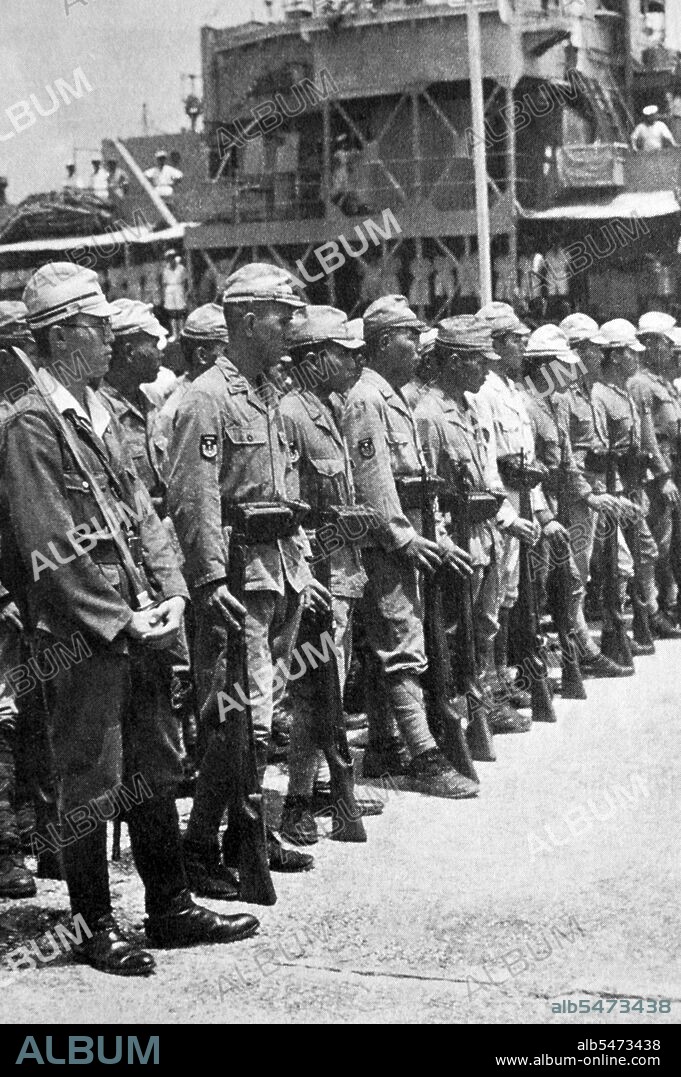alb5473438
Vietnam: Armed Japanese troops in Saigon under British control after Japanese surrender,1945

|
Add to another lightbox |
|
Add to another lightbox |



Buy this image.
Select the use:

Title:
Vietnam: Armed Japanese troops in Saigon under British control after Japanese surrender,1945
Caption:
In September 1945, 20,000 British troops of the 20th Indian Division occupied Saigon under the command of General Sir Douglas David Gracey. During the Potsdam Conference in July 1945, the Allies had agreed on Britain taking control of Vietnam south of the 16th parallel (then part of French Indochina) from the Japanese occupiers. Meanwhile, Ho Chi Minh proclaimed Vietnamese independence from French rule and major pro-independence and anti-French demonstrations were held in Saigon. Ho Chi Minh was the leader of the communist Viet Minh. The French, anxious to retain their colony, persuaded Gracey's Commander in Chief, Lord Mountbatten, to authorise Gracey to declare martial law. Fearing a communist takeover of Vietnam, Gracey decided to rearm French citizens who had remained in Saigon. He allowed them to seize control of public buildings from the Viet Minh. In October 1945, as fighting spread throughout the city, Gracey issued guns to the Japanese troops who had surrendered. He used them to help maintain colonial rule. According to some socialist and communist commentaries, this controversial decision furthered Ho Ch Minh's cause of liberating Vietnam from foreigners' rule and precipitated the First Indochina War. French General Leclerc arrived in Saigon in October 1945 to assume authority but it was not until well into the first half of 1946 that enough French troops had arrived to allow General Gracey to return with his troops to India where the 20th Indian Division was disbanded.
Credit:
Album / Pictures From History/Universal Images Group
Releases:
Image size:
3393 x 5100 px | 49.5 MB
Print size:
28.7 x 43.2 cm | 11.3 x 17.0 in (300 dpi)
Keywords:
ASIA IMAGE • ASIA PICTURES • ASIA • ASIAN IMAGE • ASIAN IMAGES • ASIAN PICTURES • ASIAN • BRITAIN • BRITISH • COLONIALISM • ENGLAND'S • ENGLAND • ENGLISH • FRANCE • FRANCE. • FRENCH • GENERAL ROSE • GREAT BRITAIN • GREAT-BRITAIN • GUERRA • HISTORIA UNIVERSAL • HISTORIA • HISTORICAL IMAGES • HISTORICAL PICTURES • HISTORICAL • HISTORY IMAGES • HISTORY PICTURES • HISTORY • HISTORY. • HUNDRED YEARS WAR • IMPERIALISM • INDOCHINA WARS • JAPAN • JAPANESE • LA FRANCE • MILITAR • MILITARS • MILITARY • SAIGON • U. K. • UNITED KINGDOM • VIETNAM • VIETNAMESE • WAR • WARFARE • WARS
 Pinterest
Pinterest Twitter
Twitter Facebook
Facebook Copy link
Copy link Email
Email
